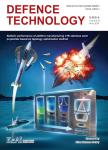Investigation of high rate mechanical flow followed by ignition for high-energy propellant under dynamic extrusion loading
作者机构:State Key Laboratory of Explosion Science and TechnologyBeijing Institute of TechnologyBeijing 100081China School of Aerospace EngineeringBeijing Institute of TechnologyBeijing 100081China
出 版 物:《Defence Technology(防务技术)》 (Defence Technology)
年 卷 期:2024年第32卷第2期
页 面:336-347页
核心收录:
学科分类:080703[工学-动力机械及工程] 08[工学] 082502[工学-航空宇航推进理论与工程] 0807[工学-动力工程及工程热物理] 0835[工学-软件工程] 0825[工学-航空宇航科学与技术]
基 金:National Natural Science Foundation of China(U22B20131) State Key Laboratory of Explosion Science and Technology(QNKT23-10)for supporting this project
主 题:NEPE propellant Crevice extrusion Shear flow Sample thickness Ignition reaction
摘 要:Investigating the ignition response of nitrate ester plasticized polyether(NEPE) propellant under dynamic extrusion loading is of great significant at least for two cases. Firstly, it helps to understand the mechanism and conditions of unwanted ignition inside charged propellant under accident ***, evaluates the risk of a shell crevice in a solid rocket motor(SRM) under a falling or overturning scene. In the present study, an innovative visual crevice extrusion experiment is designed using a dropweight apparatus. The dynamic responses of NEPE propellant during extrusion loading, including compaction and compression, rapid shear flow into the crevice, stress concentration, and ignition reaction, have been firstly observed using a high-performance high-speed camera. The ignition reaction is observed in the triangular region of the NEPE propellant sample above the crevice when the drop weight velocity was 1.90 m/s. Based on the user material subroutine interface UMAT provided by finite element software LS-DYNA, a viscoelastic-plastic model and dual ignition criterion related to plastic shear dissipation are developed and applied to the local ignition response analysis under crevice extrusion conditions. The stress concentration occurs in the crevice location of the propellant sample, the shear stress is relatively large, the effective plastic work is relatively large, and the ignition reaction is easy to occur. When the sample thickness decreases from 5 mm to 2.5 mm, the shear stress increases from 22.3 MPa to 28.6 MPa, the critical value of effective plastic work required for ignition is shortened from 1280 μs to 730 μs, and the triangular area is easily triggering an ignition reaction. The propellant sample with a small thickness is more likely to stress concentration, resulting in large shear stress and effective work, triggering an ignition reaction.



